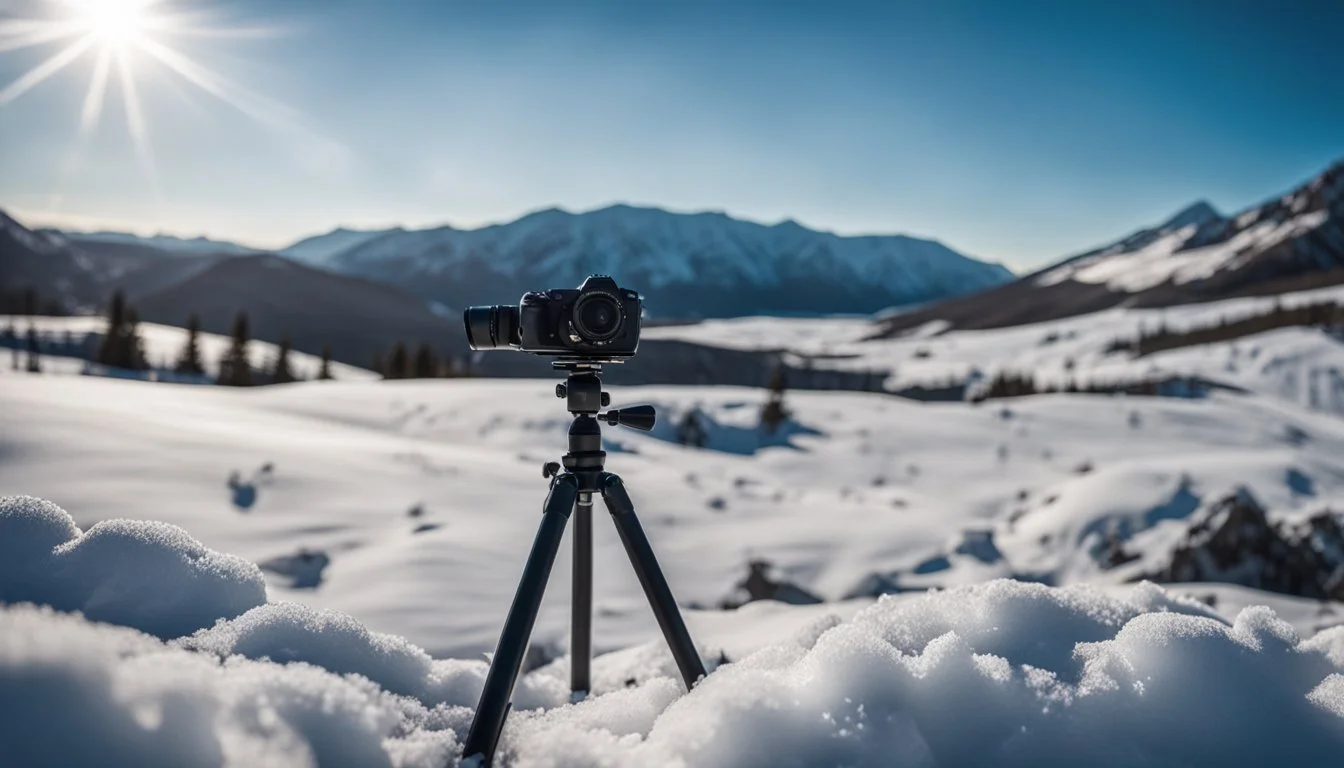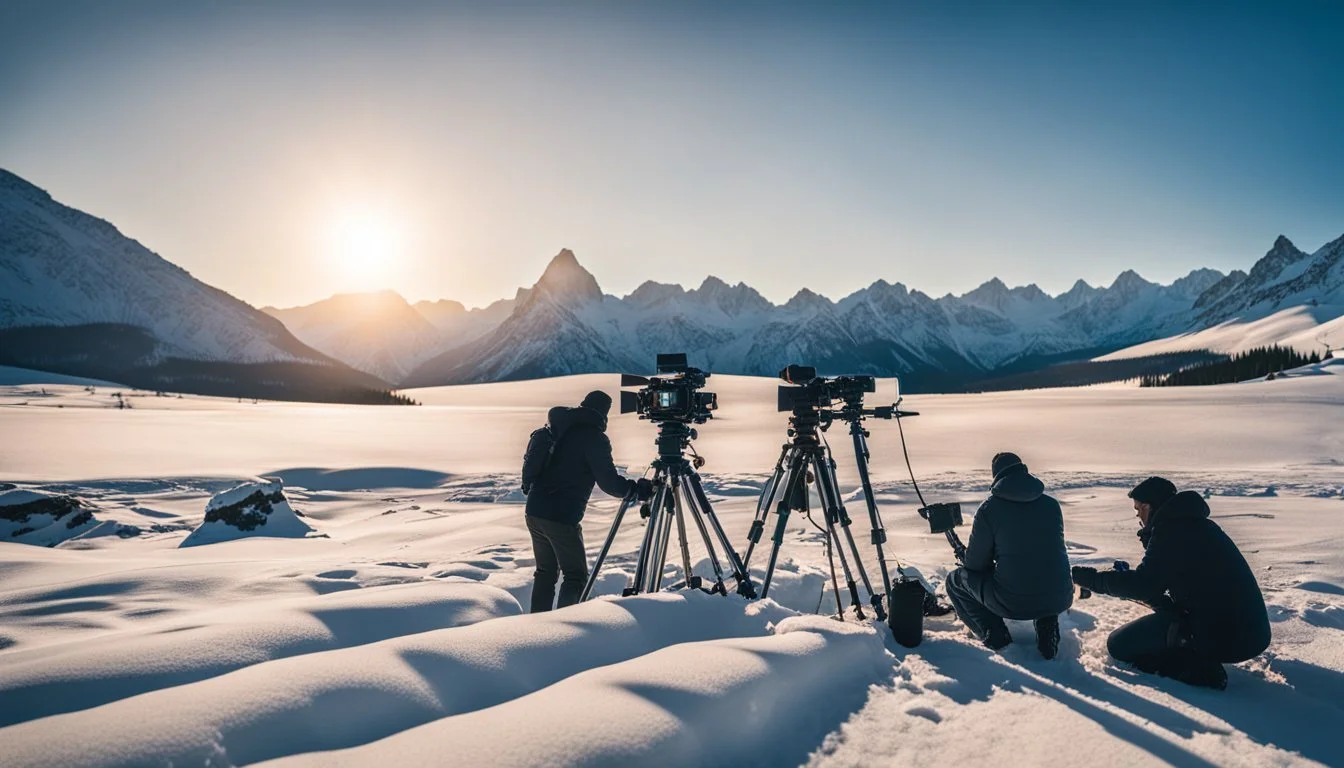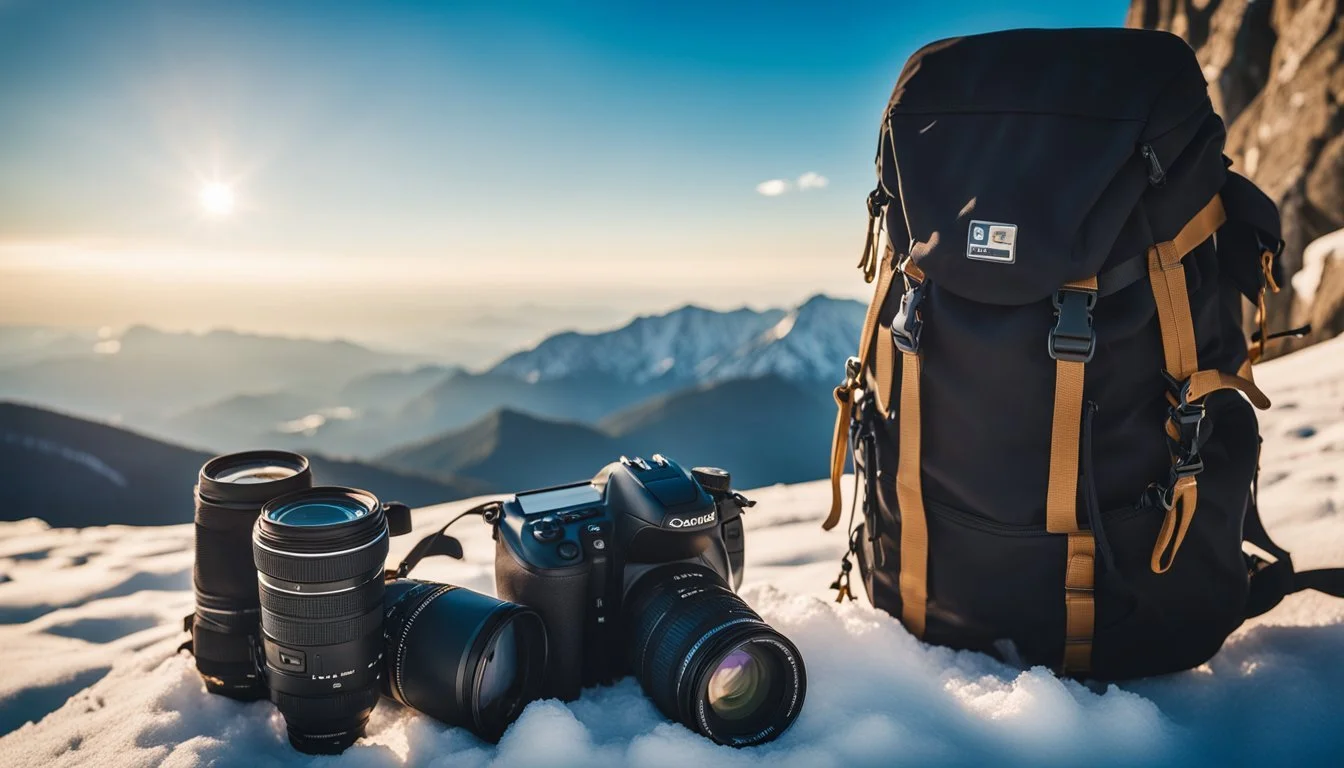13 Essential Tips for Filming in Extreme Temperatures
Expert Strategies for Success
Filming in extreme temperatures presents unique challenges that go beyond the usual considerations of camera settings and shot composition. Mastering the techniques to handle your equipment and manage environmental obstacles is crucial for capturing high-quality footage in these conditions. Whether it's the blistering heat of a desert or the frigid cold of tundra regions, understanding the impact of such climates on both man and machine can be the difference between success and failure.
For filmmakers and videographers, ensuring that their gear functions optimally in harsh weather conditions is only part of the equation. Adapting to the physical and logistical demands of these environments will enhance the quality of the visuals and the efficiency of the shoot. As extreme temperatures can be unpredictable, preparation and knowledge are key components to avoid potential pitfalls and ensure a smooth filming experience.
1) Invest in High-Quality Thermal Gear
Filming in extreme temperatures requires durable and effective thermal gear to protect both the equipment and the crew. Insulated camera bags and thermal covers help maintain optimal temperature for your gear, ensuring it performs well despite the harsh conditions.
Look for gear made from high-quality materials designed to withstand extreme weather. Proper insulation can prevent condensation from forming inside equipment, which can lead to significant damage.
Thermal clothing for the crew is also essential. Wearing layers made from moisture-wicking and insulating fabrics can keep everyone comfortable and focused on the task at hand.
Using thermal protection for batteries and electronic components is crucial. Cold temperatures can reduce battery life significantly, so investing in insulated battery cases or warmers can help maintain their performance.
Equipping yourself and your team with the appropriate thermal gear will not only ensure the safety and longevity of your equipment but also enhance the efficiency and comfort of the filming process.
2) Use Windshields to Protect Microphones
Wind noise is a common issue when filming in extreme temperatures, especially in windy conditions. Wind interacting with the microphone's diaphragm can create turbulence, causing a low-frequency rumble that can overshadow desired audio. This makes it difficult to capture clear sound.
Using windshields can significantly mitigate this problem. These devices, also known as windscreens, act as barriers to wind, preventing it from directly hitting the microphone capsule.
There are different types of windshields, including foam windshields and furry windshields like deadcats. Foam windshields are useful for light wind conditions, while deadcats are more effective in strong wind scenarios.
Selecting the appropriate windshield for your microphone is crucial. The fit should be snug to ensure optimal wind protection. Position the windshield to cover the entire microphone grille adequately.
Windshields also help in reducing other unwanted noises, such as vocal pops and breath sounds. They allow the microphone to capture clearer and more precise sound, essential for professional audio quality in film production.
3) Consider Battery Warmers
Battery performance degrades quickly in cold temperatures. Using battery warmers can help mitigate this issue. Keeping batteries warm ensures consistent power output and longevity, which is essential during extended shooting sessions.
Hand warmers can be taped directly to the camera body. This method is effective for keeping the battery warm while in use. Another useful approach is to keep spare batteries close to your body, such as in an inside coat pocket.
Specialized battery warming cases are also available. These cases are designed to maintain a consistent temperature for batteries, providing an additional layer of protection against the cold. They can be especially useful in extreme conditions.
By using battery warmers, photographers and videographers can ensure that their equipment remains functional and reliable. This approach minimizes the risk of battery failure and reduces the need for frequent battery changes.
4) Plan Shorter Shooting Sessions
Cold weather can quickly sap energy from both the crew and the equipment. To manage this, shorter, more focused shoots are essential.
Limited exposure to the elements helps prevent potential damage to cameras and gear. Cold can drain batteries faster and affect the performance of various components.
Planning shorter sessions also allows for maintaining a creative edge without overexertion. Consistent breaks to warm up can help everyone stay comfortable and alert.
By dividing tasks into smaller segments, each shoot can remain productive and efficient. This strategy ensures that quality remains high despite challenging conditions.
5) Choose the Right Storage Solutions
Choosing the right storage location is vital for protecting and preserving camera equipment. Excessive humidity levels should be avoided. High humidity can lead to mold growth and damage delicate camera components.
It is best to store cameras in a cool, dry place. A camera bag with proper padding can offer additional protection against physical damage.
Use silica gel packets in the storage area to absorb extra moisture. These packets help in maintaining a dry environment, safeguarding the camera from potential humidity damage.
For those on the move, a weather-sealed case can provide excellent protection. It keeps out moisture, dust, and other environmental factors that could harm the camera.
Always return the camera to its storage spot after use. This habit ensures the equipment remains in optimal condition and is ready for the next shoot.
In cold climates, it's advisable to use a plastic bag to prevent condensation. When moving from cold to warm places, the bag helps to balance the temperature change and protect the camera.
6) Check Equipment Regularly for Ice Build-Up
Ice build-up on filming equipment can cause significant issues. Cameras, microphones, and other devices can malfunction if ice forms on critical components. It's important to inspect these items frequently, especially when shooting in cold environments.
Examine lenses for any signs of condensation or frost. If ice is present, carefully wipe it away to avoid scratching the lens. Make sure to check camera buttons and dials, as ice can impair their functionality.
Inspect cables and connectors, particularly where they join equipment. Ice on these connections can lead to issues with power and signal transmission. Regularly cleaning and drying cables can prevent ice from forming.
Batteries are also vulnerable to ice build-up. Ensure they are dry and free of condensation. Keeping spare batteries in a warm pocket can help maintain their effectiveness.
By routinely checking for ice, you can keep your equipment in optimal working condition. This prevents unexpected interruptions and ensures a smoother filming experience in extreme temperatures.
7) Use Hand Warmers for Cameras
Hand warmers can be a crucial tool when filming in extreme temperatures. The primary advantage is their ability to prevent camera batteries from draining too quickly in cold environments.
Place hand warmers inside the camera bag near the batteries and key electronic components. This helps maintain a stable temperature, reducing the risk of equipment failure.
Hand warmers can also be attached to the exterior of the camera body. Use adhesive-backed warmers or secure them with rubber bands. This wards off frost and keeps the controls functional.
It’s essential to monitor the temperature of the camera. Excessive heat from the warmers can harm the equipment, so balance is vital. Ensuring the right warmth extends the battery life and keeps the camera operational.
Incorporating hand warmers is a simple yet effective strategy for tackling extreme cold.
8) Master White Balance Adjustments
White balance is critical when filming in extreme temperatures. Different environments can significantly alter the color temperature, affecting the final look of your footage. Adjusting the white balance ensures your colors are accurate.
Cameras usually offer preset white balance settings such as cloudy, daylight, and tungsten. These work well in general but can be insufficient in extreme weather conditions.
One method to achieve precise white balance is using the Kelvin setting on your camera. Kelvin allows for manual adjustments, giving greater control over the color temperature. This can be particularly useful in extreme lighting conditions.
If shooting in RAW format, you can fine-tune the white balance during post-processing. This provides flexibility and helps correct any color casts later without reducing image quality.
In scenes with mixed lighting, consider using a grey card to set a custom white balance. This technique helps the camera accurately interpret the lighting conditions, producing more consistent results.
Taking the time to master white balance adjustments helps maintain color accuracy and enhances the overall quality of your footage, especially in challenging environments.
9) Carry Extra Power Sources
Cold temperatures can drain batteries rapidly. It’s vital to carry spare batteries to ensure that filming can continue without interruptions. Cameras, lights, and other electronic gear will all require backup power.
Store spare batteries close to your body to keep them warm. This can extend their lifespan and functionality in freezing conditions. Chemical hand-warmers can also be placed around batteries to maintain their effectiveness.
Using a dummy battery connected to an external power source can provide consistent power. Opt for DC cables that are designed for low temperatures to avoid issues with brittleness. Ensuring a reliable power source can prevent frustrating interruptions during critical moments.
When filming in extreme cold, plan battery usage carefully. Rotate batteries periodically to ensure each one stays operational. Fully charged batteries are critical, as partial charges can deplete more quickly in harsh weather.
10) Maintain Fluid Movements with Tripods
In extreme temperatures, using a fluid head tripod can make a significant difference in maintaining smooth camera movements. Selecting a tripod head with an adjustable counterbalance feature helps manage the extra weight that may come with additional gear needed for extreme conditions.
A tripod with a fluid drag system offers precision and control over panning and tilting. This is particularly important in challenging environments where steady shots are crucial. The fluid drag system allows for seamless transitions, capturing professional-grade footage.
Ensure that all knobs and levers on the tripod are not over-tightened, as this can strain components. Over-tightening could lead to malfunctions, especially in extreme temperatures where materials can become more brittle or expand.
Storing the tripod properly is essential. When not in use, keep it in a cool, dry place away from extreme temperatures or direct sunlight. This helps preserve its structural integrity and prolong its lifespan, ensuring it remains reliable for fluid movements.
11) Understand Local Weather Patterns
To effectively film in extreme temperatures, it's crucial to understand the local weather patterns of the location.
Research the climate and typical weather conditions for different times of the year. This helps anticipate any potential challenges and plan appropriately.
Utilize tools such as weather radar and local weather updates. These resources provide real-time information on precipitation, storms, and temperature fluctuations.
Stay informed on any sudden changes in weather. Rapid shifts can affect both equipment functionality and crew safety.
Consult local experts or guides who have firsthand experience with the area's weather. Their insights can be invaluable for preparation.
Plan buffer days in the schedule to accommodate unexpected weather conditions. Flexibility ensures the project stays on track without compromising safety or quality.
12) Utilize Compact and Lightweight Gear
Using compact and lightweight gear is crucial when filming in extreme temperatures. Heavy and bulky equipment can be cumbersome and difficult to manage in challenging conditions.
Smaller gear allows for easier mobility and reduces fatigue. It’s also more convenient to pack and carry, especially when trekking through snow or rugged terrain.
Lightweight equipment tends to be more versatile. It can be quickly repositioned for the best shots and fitted into tight spaces more easily than larger, heavier setups.
Battery life is also critical in extreme temperatures. Compact gear often requires less power, which is an advantage when batteries drain faster in cold weather.
Consider using mirrorless cameras instead of DSLRs. Mirrorless models are typically smaller and lighter, while still delivering high-quality footage.
Choose tripods and supports made from durable, yet light materials like carbon fiber. These options offer stability without adding unnecessary weight.
Streamlining gear ensures filmmakers can focus on capturing the moment without being bogged down by unwieldy equipment.
13) Keep Lenses Free from Condensation
Condensation can be a significant problem when filming in extreme temperatures.
To prevent your lenses from fogging up, allow your camera and lenses to gradually adjust to the external temperature. Quickly transitioning between warm and cold environments can cause condensation on the glass.
Using a plastic bag can help. Place your camera inside the bag before moving it from one temperature to another. This helps to equalize the temperature and reduce condensation.
Another effective method is to use moisture-absorbing products, like silica gel packs, in your camera bag. These will help to absorb any excess moisture and keep your equipment dry.
Regularly clean your lenses with a microfiber cloth. This ensures that any moisture, grime, or fingerprints are promptly removed, maintaining clear visibility.
By taking these proactive steps, you can maintain the performance of your camera lenses and ensure high-quality footage, even in extreme temperatures.
Preparing Your Gear
When filming in extreme temperatures, safeguarding your gear from harsh elements and ensuring reliable power supply are paramount.
Weatherproofing Equipment
Weatherproofing your gear involves protecting it from moisture, dust, and extreme temperatures. Use rain covers for your cameras to prevent snow, sleet, and rain from seeping in.
Large plastic bags can serve as impromptu protection for your equipment. Seal your gear in these bags when transitioning between warm and cold environments to prevent condensation.
Consider using camera wraps or insulated cases to keep your equipment warm. These items help in maintaining a more consistent internal temperature, thus reducing the risk of damage from cold stress.
Invest in silica gel packs to absorb moisture and keep your gear dry. Avoid changing lenses frequently outdoors to minimize the exposure of camera internals to harsh weather.
Choosing the Right Batteries
Cold temperatures can significantly reduce battery life, so it's important to choose the right batteries. Lithium-ion batteries perform better in cold conditions compared to their Nickel-Metal Hydride (NiMH) counterparts.
Bring extra batteries and keep them close to your body heat, like in an inside coat pocket. This helps to maintain their warmth and efficiency. Rotate them frequently to ensure they stay warm and functional.
Consider using an external battery pack connected via a dummy battery. It can be stored in a warmer place, such as a coat pocket, to prolong its performance.
Using hand warmers can also help. Attach them to your battery compartment to prevent the temperature from dropping too low. This technique can give you a bit more shooting time in extreme cold.
Safety Considerations
When filming in extreme temperatures, safety needs to be a top priority. Extreme cold and heat can pose serious health risks such as frostbite and heat stroke. Proper attire and precautionary measures are critical to ensure both personal safety and the longevity of equipment.
Handling Frostbite and Heat Stroke
Frostbite occurs when the skin and underlying tissues freeze due to prolonged exposure to cold temperatures. Early signs include numbness, tingling, and pale or hard skin. To manage, immediately move to a warmer area and avoid rubbing the affected area, which can damage tissues further. Rewarming should be done with warm (not hot) water.
Heat stroke is a severe heat illness where the body overheats. Symptoms include a body temperature above 103°F, rapid pulse, confusion, and unconsciousness. If identified, it's crucial to cool down immediately using ice packs, cool water, and seeking medical help urgently. Staying hydrated and taking breaks in shaded or air-conditioned areas can prevent heat stroke.
Dressing for the Weather
Proper clothing is essential for protection against extreme temperatures. In cold environments, dressing in layers helps maintain body heat, with thermal underwear, insulated jackets, and waterproof outer layers being ideal. Warm gloves, hats, and scarves are also necessary to protect extremities.
In hot settings, lightweight, light-colored, and loose-fitting clothing helps keep the body cool. Fabrics like cotton and moisture-wicking materials are preferred. Use a wide-brimmed hat to protect against the sun, and apply sunscreen to exposed skin. Wearing sunglasses reduces glare and UV exposure, while breathable footwear prevents overheating and protects feet.
Ensuring the right clothing can prevent both frostbite and heat stroke, allowing for safer filming in challenging environments.
Technical Tips
Extreme temperatures can pose a variety of challenges for filmmakers. Key areas of focus include maintaining battery life and managing condensation issues.
Maintaining Battery Life in Extreme Cold
Batteries tend to drain quickly in cold weather. To combat this, invest in high-capacity batteries that are designed for low temperatures. Keep spare batteries in an inside pocket close to your body to keep them warm and switch them out as needed. Battery warmers can also be useful accessories.
Use a dummy battery with a DC cable connected to an external power source. This can provide continuous power and mitigate battery drain. Be sure to carry extra batteries and power sources to ensure you can keep filming without interruptions.
Dealing with Condensation
Condensation can damage camera equipment when moving between different temperature zones. Use a large plastic bag to acclimate your camera by placing it in the bag before moving between environments. This will help control the rate at which the camera adjusts to temperature changes.
Make sure your camera gear has a chance to dry out in a warm, dry place after exposure to cold and damp conditions. Avoid turning gear on too quickly after entering a warmer space to prevent internal condensation. Silica gel packets can be placed in camera bags to absorb moisture.







